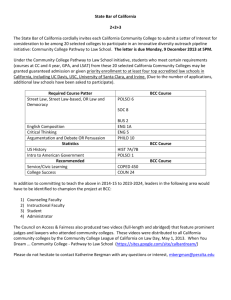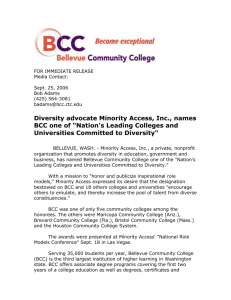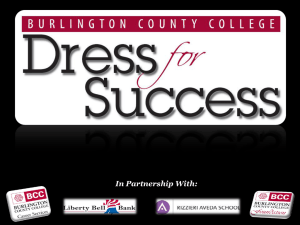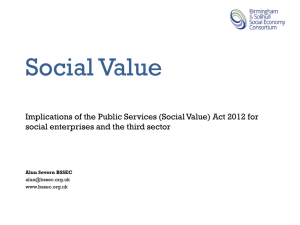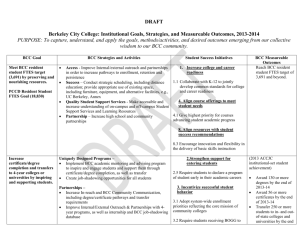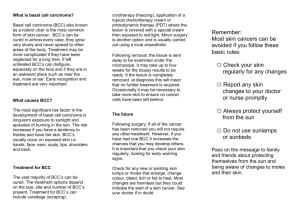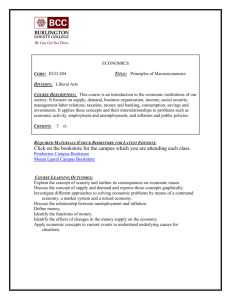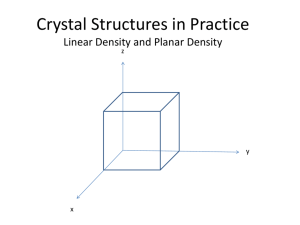Abstract of the Self Evaluation I.A: Mission Berkeley City College's
advertisement
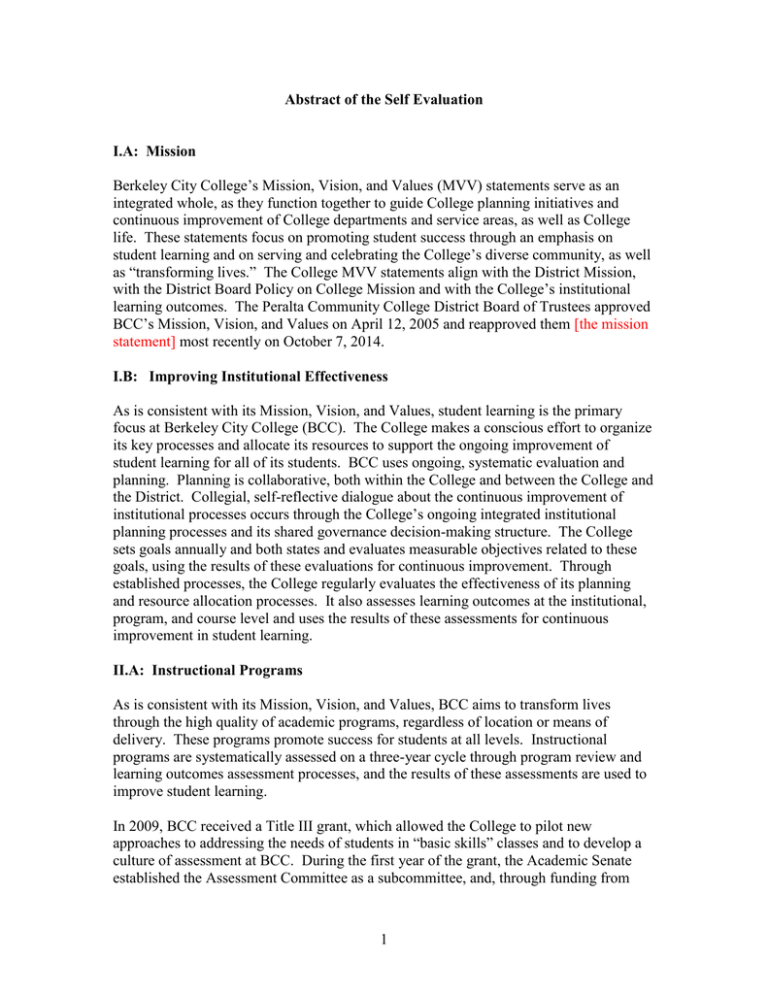
Abstract of the Self Evaluation I.A: Mission Berkeley City College’s Mission, Vision, and Values (MVV) statements serve as an integrated whole, as they function together to guide College planning initiatives and continuous improvement of College departments and service areas, as well as College life. These statements focus on promoting student success through an emphasis on student learning and on serving and celebrating the College’s diverse community, as well as “transforming lives.” The College MVV statements align with the District Mission, with the District Board Policy on College Mission and with the College’s institutional learning outcomes. The Peralta Community College District Board of Trustees approved BCC’s Mission, Vision, and Values on April 12, 2005 and reapproved them [the mission statement] most recently on October 7, 2014. I.B: Improving Institutional Effectiveness As is consistent with its Mission, Vision, and Values, student learning is the primary focus at Berkeley City College (BCC). The College makes a conscious effort to organize its key processes and allocate its resources to support the ongoing improvement of student learning for all of its students. BCC uses ongoing, systematic evaluation and planning. Planning is collaborative, both within the College and between the College and the District. Collegial, self-reflective dialogue about the continuous improvement of institutional processes occurs through the College’s ongoing integrated institutional planning processes and its shared governance decision-making structure. The College sets goals annually and both states and evaluates measurable objectives related to these goals, using the results of these evaluations for continuous improvement. Through established processes, the College regularly evaluates the effectiveness of its planning and resource allocation processes. It also assesses learning outcomes at the institutional, program, and course level and uses the results of these assessments for continuous improvement in student learning. II.A: Instructional Programs As is consistent with its Mission, Vision, and Values, BCC aims to transform lives through the high quality of academic programs, regardless of location or means of delivery. These programs promote success for students at all levels. Instructional programs are systematically assessed on a three-year cycle through program review and learning outcomes assessment processes, and the results of these assessments are used to improve student learning. In 2009, BCC received a Title III grant, which allowed the College to pilot new approaches to addressing the needs of students in “basic skills” classes and to develop a culture of assessment at BCC. During the first year of the grant, the Academic Senate established the Assessment Committee as a subcommittee, and, through funding from 1 both the Title III grant and the Basic Skills Initiative, the College developed a TeachingLearning Center, which became instrumental in supporting faculty projects that served to build a culture of assessment and help faculty and staff throughout BCC to implement action plans based on assessments. By the end of the grant period, in Spring 2014, SLO assessment – at the course, program, and institutional level – had become pervasive at the College and was used to make meaningful improvements in instructional programs. The College uses program reviews and APUs to connect this work to its planning processes. Achievement indicators reveal that BCC students are meeting their goals. The most commonly cited of these is transfer to a four year college or university, but many students also indicate goals related to improving job skills or gaining degrees or certificates. In all of these areas, students are showing improvement, most notably in the increases in transfers and in degrees and certificates awarded. This growth is likely to continue, as the College now has fourteen Associate Degrees for Transfer, which help students seamlessly transfer to colleges in the California State University system. II.B: Student Services As outlined in the College’s Mission, Vision, and Values, BCC is committed to providing a “diverse community with educational opportunities.” Student support services are provided throughout students’ careers at BCC, while transfer and career services are available to help them transition to the next steps, academically and professionally. The College’s broad spectrum of student support services ensures equal access to learning opportunities, campus resources, and tools of success for all students. Specialized services are provided for targeted student populations, such as students with disabilities, veterans, first generation students, and ESL, economically challenged, and academically underprepared students. These services are systematically assessed to continuously improve their effectiveness. The Student Services Division ensures that its programs are assessed in a variety of ways. Ongoing dialogue about student services occurs within the College’s shared governance groups and committees and at district-level meetings. Every program has service area outcomes and may also have student learning outcomes, which are linked to the program’s mission. These are assessed primarily through surveys, and results of assessments are used to promote continuous improvement. Outside surveys also provide data for assessment, as do achievement indicators, such as student persistence and transfer rates. Assessment findings are used in such planning documents as program reviews and APUs, the College’s Educational Master Plan, the Student Success and Support Plan (SSSP), and the Equity Plan. The Student Services Division is meeting the mandate of the Student Success Act of 2012 through its SSSP by proactively and innovatively providing enhanced services in relation to student educational plans; orientation, assessment, placement, counseling, advising, and other educational planning services for first-time students; and follow-up services. It provides access to services online. 2 II.C: Library and Learning Support Services Library and learning support services are of sufficient quantity, quality, currency, depth, and variety to sufficiently support BCC’s instructional programs, regardless of location or means of delivery. BCC library resources are sufficient to facilitate educational offerings. The College relies on appropriate expertise of faculty, including librarians and other learning support services professionals, to support student learning and enhance the achievement of the College’s Mission, Vision, and Values. Through the Library’s print materials, online materials, in-class orientations, and Library Information Sciences classes, as well as services provided by the Learning Resources Center (LRC), the College provides ongoing instruction in information competency. An increase in library hours between 2008 and 2014 has led to demonstrable improvements in students’ satisfaction with the library, as indicated in survey results, and a clear increase in use of the Library, as indicated through usage analyses. Learning support services are offered in a variety of venues at the College; the hiring of a full-time LRC coordinator will improve coordination of these services. III.A: Human Resources BCC employs a sufficient number of qualified personnel to support student learning programs and services wherever offered and by whatever means delivered, treats them equitably, systematically evaluates them, and provides opportunities for their professional development. Human resources planning is integrated with institutional planning through the program review/APU cycle and the College’s shared governance decision-making processes. In hiring practices, the College adheres to board policies and administrative procedures. It also adheres to well-established and well-documented practices for evaluating personnel, which are consistent with union contracts, as well as board policies and administrative procedures and to established board policies and administrative procedures that ensure fairness and integrity in all employment procedures. Professional development at BCC is coordinated through the Professional Development Committee, which provides workshops and activities that promote pedagogical training, and the Teaching-Learning Center, which promotes data-driven, assessment-related opportunities for collaborative work that promotes student learning. III.B: Physical Resources Physical resources of BCC are safe and sufficient, and they support the integrity and quality of the College’s programs and services, regardless of location or means of delivery. The main building, located at 2050 Center Street, is a full modern facility that is not ten years old and is easily accessible by public transportation. Students have clearly indicated their satisfaction with the safety, sufficiency, accessibility, and healthy environment of the building. The College also utilizes rented facilities, primarily at U.C. Berkeley and in its “South Campus.” South Campus meets acceptable standards of accessibility, safety, healthfulness, and security and is ADA compliant. The property owner of the South Campus building handles maintenance and custodial work there. Similarly, U.C. Berkeley handles issues of maintenance for the rooms the College uses 3 there. In order to provide sufficient resources to meet the demands of student growth, the College is working with the District to acquire new facilities. III.C: Technology Resources Technology resources are used at BCC to support student learning programs and services, and technology planning is integrated with college-wide planning through the College’s committee structures and through the integration of technology planning within program reviews and APUs. At BCC, technology supports instruction; the Library and learning support services; and Student Services, including Admissions and Records, Financial Aid, and Counseling, among others. Assistive technology is available to provide support for students with disabilities. Distance education tools, such as moodle and turnitin.com, have proven to be so effective that they are now used to enhance face-to-face instruction as well as distance education courses. The College uses its planning processes to identify technology needs. III.D: Financial Resources Financial resources at BCC are sufficient to support student learning programs and services and to improve institutional effectiveness. The College is in sound financial shape due to a combination of prudent financial stewardship, strong community and voter support of general obligation bonds, a parcel tax measure, and careful use of a series of state and federal grants. The College and District ensure financial stability, integrity in financial management, and strong integration of resources planning with college-level and district-level planning. Through established business practices, internal controls ensure that financial transactions are appropriately reviewed. College financial resources, including auxiliary and grant funds, are managed with integrity and in a manner consistent with Mission, Vision, and Values of the College, and the College follows board policies and administrative procedures that ensure sound financial practices and financial stability. In 2010, the District Planning and Budgeting Council created a “budget allocation model” (BAM) for the unrestricted general fund. Based on this model, the District determines the amount to be allocated to each college, using a three-year rolling average of full-time equivalent students at each one. One principle of the BAM has been that it should be implemented in a way that avoids “negative operational impacts to programs and services” at any of the colleges. As a result, the full implementation of the BAM has been gradual and is not yet complete. While the College meets Standard III.D, BCC and the District will continue to pursue the full implementation of the BAM. IV.A: Leadership and Governance At BCC, institutional leaders create an environment for empowerment, innovation and excellence, while taking on the responsibilities of their positions. The College has a clear and well-articulated shared governance structure and clearly defined processes for annual 4 institutional planning and budgeting. The governance structure and planning processes of the College ensure robust participation from staff, faculty, administrators, and students. The College engages in ongoing assessment and evaluation of its shared governance processes and their effectiveness. Over the last year, the College, for example, has streamlined its shared governance structure and combined or revamped existing committees to make the overall structure more effective. The “small college culture” of BCC has historically stimulated the free flow of ideas. The College is committed to maintaining and strengthening a culture of collaboration and communication and to fostering the discussion of ideas and effective communication among all of its various constituencies. IV.B: Board and Administrative Organization 5
